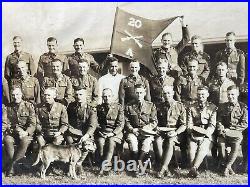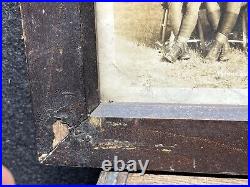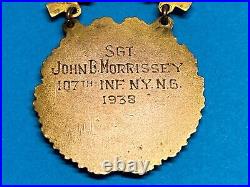



On the collar of the buttonholes on which there is the abbreviation “?? ” – “Military Academy”. The Academy of the Red Army is a higher educational institution that trained the highest command staff of the Red Army. Studying girls in it is an extremely rare occurrence! Size about 7 x 9 cm. On the back – amateur photographer stamp. 100% OLD USSR ORIGINAL! Very good for collection! PLEASE, SEE THE PICTURES. Please see my other items, there are many interesting things!! Have a good shopping!






Unmarked blued WWI1 takedown tool / screwdriver for the Colt 1911/ 1911a1. May have grease, oil or some minor rust on the surface.



















Vtg 1928 US Army Infantry Regiment Fort D. A Russell WY Photo “Basketball Champs”. Vintage framed photo in good original condition and in original frame. Frame show some wear from age and storage. See all photos for condition. Overall measurements are 21″ x 10.75″.





Professionally made reproduction of a guidon used by the China Marines Mounted Detachment in the 1930s. The flag is swallow tail in design and measures approximately 28″x 19″. Design was taken from an photograph of the original (second picture), located in the museum at the Naval Shipyard in Washington D. One of a kind.















1938, ARMY LEVEL PRIZE, BRONZE, RIFLE COMPETITION, INFANTRY, NAMED, w/RESEARCH. This 1938 Infantry Army Level Prize for Rifle Competition was awarded to SGT John B. Morrissey, Company I, 107. SGT Morrissey was born on 30 January, 1908, Pocatello, Idaho. SGT Morrissey enlisted on 21 January 1936. When John Bacon Morrissey was born on January 30, 1908, in Pocatello, Idaho, his father, Harry, was 30 and his mother, Florence, was 23. He had two sons and two daughters with Anna R Morrissey. He died on February 3, 1982, in Aberdeen, Maryland, at the age of 74. These interwar Army marksmanship badges are highly sought after among collectors. We will include printed copies of the research artifacts. This Army level prize consists of three parts. Top bar that indicated either Army level or Corps / department level competition and served as a brooch to affix the assembled device to the uniform. The top bar is squared ended and ornamented with oak leaves, and was always worn with this bronze clasp and an enameled planchet prior to WWII. The top bar or brooch is a pin back with a functional rotating clasp closure. The second portion consists of an intermediate clasp of crossed arms to indicate the type of weapon that was used to earn the award rifle, pistol, or, soon thereafter, automatic weapons. In this case it has crossed rifles. The third, lower piece is a planchet, that when enameled, told the arm or the type of service, in this case, blue for Infantry. The central design is a bow and a pair of arrows. The planchet consists of three concentric designs. 0625 in diameter, displays a compound bow and two crossed arrows, a symbol of marksmanship. Outside of that is a center ring, 015 in width, which displays 13 stars. An oak-leaf wreath executed in bronze surrounds the entire design, making the planchet 1-1/2 in width. The combatant arms had bronze stars with the ring enameled in blue for Infantry.












Japanese 1931-34 Manchurian Incident War Medal in case. Medal has the original ribbon with hook and eye attachment. On the bar is written “Military Medal of Honor” reading from right to left. Medal is in hard-shelled box of issue with recessed portion for the medal and golden kanji on top of case. Worn and used condition. The ribbon is decorated with the shade vine of Seocho, which appears in “Kojiki”, to express the honor of the incident. The crimson color means the intense loyalty, the red sincerity of the Yamato people and the Japanese flag and the yellow color means the birth (of the Nation) of Manchuria.








Soviet Russian Russia USSR Pre WW2 10 Years October Revolution Badge Medal Order. Original Soviet Russian Pre WW2. 10 Years of October Revolution Badge. The screw plate is missing. Listing and template services provided by inkFrog.




























































